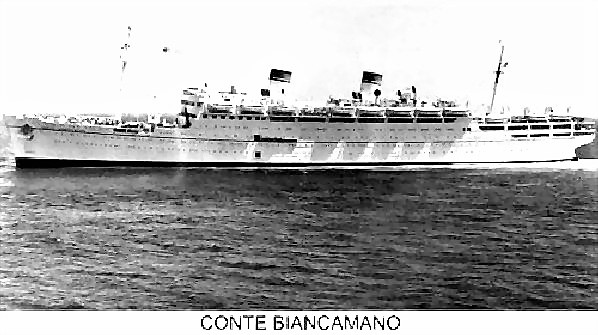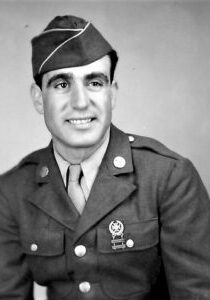People
Veterans
Master Sergeant Gabriel Licastro
12207 Coit Road

Gabriel Domenic Licastro was born in 1922 in Parghelia, Calabria, Italy. His mother and father died when he was a child. At age 11, Gabriel began working on Italian ocean liners. It was aboard various vessels that he learned to be a chef.
Gabriel was a crew member of the Italian ocean liner Conte Biancamano, named in honor of Humbert Biancamano, better known as Humbert the White-Handed. In April 1940, the ocean liner left Genoa, Italy, on a voyage to Valparaiso, Chile. Upon leaving Valparaiso, the ship received orders to proceed to Balboa, Panama, on the Pacific Ocean side of the Panama Canal, where she arrived on June 5, 1940. She continued through the canal, arriving in Cristobal, Panama, with ten passengers on board.
While in Cristobal, Italy entered the war in Europe on June 10, 1940. The Conte Biancamano was one of the largest Italian liners to have been “forgotten” in foreign waters when the war was declared. The United States impounded the Conte Biancamano on March 21, 1941, in a show of support for Britain and France. The crew caused severe damage to the engines before handing the ship over. The U.S. arrested the captain and seven officers for sabotage and transferred Gabriel and 500 fellow crewmembers to Ellis Island.
On December 11, 1941, Fascist Italy declared war on the United States. The United States reciprocated and entered World War II. The Conte Biancamano was declared a prize of war by the U.S. Government.
The U.S. sent Gabriel to the Fort Missoula Internment Camp near Missoula, Montana. The camp imprisoned approximately 1,200 non-military Italian nationals, classified as “enemy aliens.” The Italians called the internment camp Bella Vista, meaning beautiful view, but barbed wire marred their view during their stay.
The Italian internees were not alone. Missoula held over 1,000 Japanese Americans, and over 100 Germans rounded up as part of a much larger surveillance program.
Racial tensions at the camp extended to eating arrangements. Italian and Japanese internees lived in segregated quarters, with separate kitchen and dining facilities. Administrators purchased food for the Italians from a local grocery store set up by Italian immigrants who had come to work for the railroads.
President Roosevelt realized that he would need the support of the Italian American community if the United States were to invade Italy. On Columbus Day, October 12, 1942, the U.S. Attorney General declared that Italians were no longer enemies of the state.
The Second War Powers Act of 1942 exempted noncitizen armed forces service members from naturalization requirements. After enduring six months in the internment camp, the U.S. Army presented an offer for Gabriel to enlist. The Immigration and Naturalization Service (INS) traveled to Missoula to process his petition. After swearing the Oath of allegiance in open court, a naturalization judge declared in Gabriel on-site as a citizen.
There was a lag time between enlistment and call-up. Italian Americans across the United States who knew of the unique situation of the former internees, offered the new U.S. citizens an opportunity to work during this interim period as they awaited call-up. Mario Brigotti, who owned the New York Spaghetti House at 2173 East 9th Street in downtown Cleveland, offered Gabriel a job as a chef.
During his short period of employment, Gabriel met Melevenaria Concetta Di Cera, born in 1924 in Monacilioni, Campobasso, Italy, to Giovanni and Giuseppina Di Cera. Giovanni left his wife in Italy and came to the United States before World War I and served in the U.S. Army. He brought his wife and eleven-year-old daughter to the United States in 1935.
Giovanni, known as John, acquired half interest with Antonio Mazzacappa in a building at 483 East 140th Street on May 12, 1945. John opened a tavern and delicatessen in 1947. The Di Ceras lived in one of the two second-floor apartments.
John Di Cera died on May 14, 1950 and his wife acquired his half interest in the East 140th Street property. She and her daughter, Melevenaria, known as Mary, operated the business for several more years.

Gabriel served in the U.S. Army and became known as Gaby. He saw combat in the Philippines. He achieved the rank of master sergeant and served through the occupation of Japan as a General’s aide to General Bassion.
Despite the persecution they endured, approximately 1.5 million Italian Americans served in the U.S. military during World War II, and 14 received the Medal of Honor for their service. The internment of Italian Americans is a relatively unknown episode in the history of World War II, in part because of the humiliation and silence of the Italian Americans forced to live it.
Gaby and Mary corresponded throughout Gaby’s military tour abroad. After being honorably discharged, Gaby returned to the United States in late 1946 and married Mary in 1947. They began their married life in one of the second-floor apartments owned my Mary's mother on East 140th Street.
Gaby began his career as an executive chef in the Cleveland area, working in Little Italy and many private country clubs, including Acacia, Mayfield, and Beechmont. As one of the top old school chefs, he helped open the original Red Fox and Blue Fox restaurants.
Gabriel and Mary purchased a four-unit apartment building at 14602 Lake Shore Boulevard on the southeast corner of Lake Shore Boulevard and East 146th Street on October 27, 1952. Three years later, they purchased their Bratenahl home at 12207 Coit Road on November 25, 1955. They sold the 14602 Lake Shore Boulevard apartment building on May 16, 1961.
Gabe and Mary sold the Coit Road home to their son, John, on January 6, 1978. Gaby retired for health reasons in 1979, and Mary retired from her real estate and mortgage banking career at the same time. They took Mary’s mother to Italy and purchased a home in San Salvo, Italy so that she could live out the remainder of her life in the country of her birth. Josephine died four years later.
Gaby died on July 9, 1985. Mary sold the home in San Salvo. She lived with her son, John, at the 12207 Coit Road home until the age of 80 when she moved to a skilled nursing facility. Mary died on December 21, 2013, at the age of 89 and is buried alongside Gaby in All Souls Cemetery in Chardon, Ohio. They were survived by three sons: John born on May 28, 1950, Domenic born in 1953, and Gabriel born in 1958.
